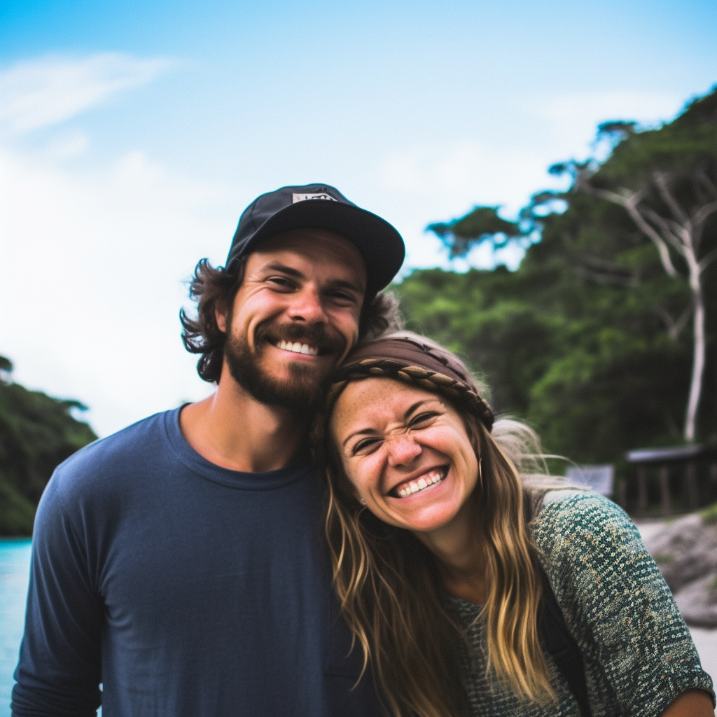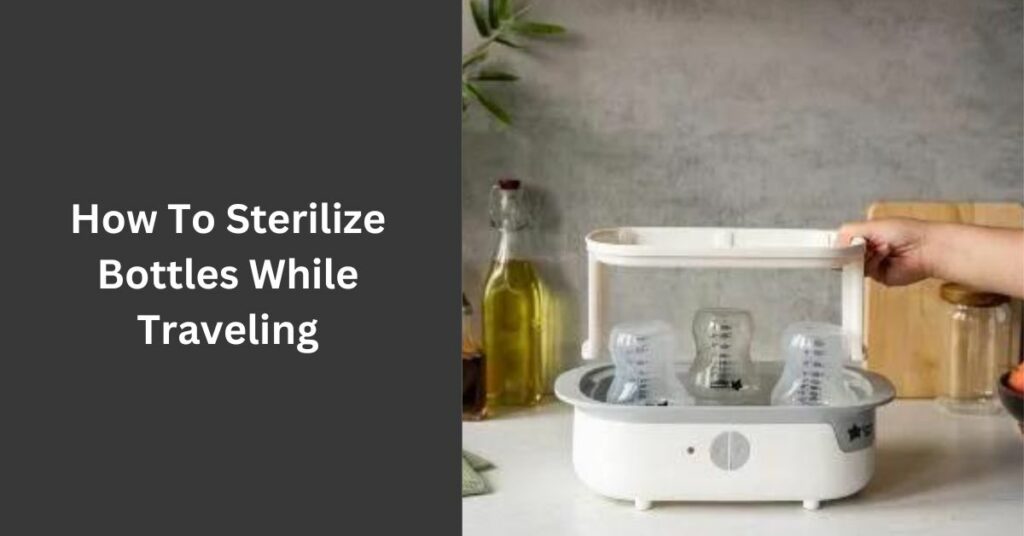As a frequent traveler and mother, I know the importance of keeping my baby’s bottles clean and sterilized while on the go. It can be daunting to think about how to maintain this level of cleanliness in unfamiliar places without access to your usual cleaning supplies.
But fear not, there are several methods for sterilizing bottles while traveling that are both practical and effective. Whether you’re camping in the wilderness or staying in a hotel room, these tips will ensure your little one’s feeding equipment stays safe and hygienic.
So pack your bags with confidence knowing you have all the tools necessary to keep your baby healthy and happy on your travels.
Plan Ahead
Before you embark on your journey, make sure to prepare in advance to keep your little one’s feeding routine smooth and worry-free. One of the most important things to consider is how you will sterilize their bottles while traveling.
First, make sure to pack all the essential items that you’ll need for sterilization, such as a bottle brush, dish soap, and a microwave steam sterilizer bag or tablets.
Time management is also crucial when it comes to sterilizing bottles while on-the-go. Make sure you have enough time in between feedings to properly clean and sterilize your baby’s bottles.
If you’ll be flying, consider bringing an extra set of empty bottles so that you can easily switch them out during layovers or delays without worrying about finding a place to wash them.
If boiling water is not available or practical for use when sterilizing your baby’s bottles while traveling, there are other options available. One method is using microwave steam sterilizer bags or tablets that can be used with any microwave oven. These products typically require only a few minutes of microwaving time and can effectively kill bacteria and viruses on your baby’s bottles.
Use Boiling Water
Using boiling water is a quick and effective way to ensure that harmful bacteria are eliminated from your baby’s feeding gear, which can be especially important when you’re away from home. Here are some benefits of boiling water to sterilize bottles while traveling:
- Boiling water kills 99.9% of germs and bacteria.
- It’s an easy and inexpensive method that requires only a pot, stove, and water.
- Boiling doesn’t require any additional products or chemicals.
- You can sterilize multiple items at once in a large pot.
- It’s environmentally friendly since it doesn’t produce any waste.
If you don’t have access to a stove or prefer an alternative to boiling, there are other options available. One alternative is using sterilizing tablets or drops that dissolve in water. Another option is using a portable UV sterilizer wand. However, these alternatives may not be as effective as boiling.
When using the boiling method, make sure to follow these steps:
- Clean the bottles and nipples thoroughly with soap and warm water before placing them in the pot of boiling water.
- Submerge the bottles completely in the boiling water for at least five minutes.
- Use tongs to remove the bottles from the hot water and place them on a clean towel to dry.
Utilizing a microwave is another convenient way to sterilize bottles while traveling.
Utilize a Microwave
If you’re staying at a hotel or Airbnb, take advantage of the microwave to easily and quickly sterilize your baby’s bottles. The process is straightforward, but it’s essential to follow microwave safety precautions.
First and foremost, ensure that the bottle is microwave-safe by checking for any warning labels or instructions from the manufacturer. Next, fill the bottle halfway with water and place it in the center of the microwave. Microwave on high for 90 seconds, then carefully remove it using tongs or oven mitts. Be cautious while removing it as there may be hot spots inside the bottle.
Pour out any remaining water and let it cool before use. It’s important to note that microwaves can vary in strength, so if you’re unsure about how long it will take to sterilize a particular item, start with shorter intervals and work your way up.
While utilizing a microwave is convenient when traveling, there are alternative methods available for those without access to one. Consider purchasing disposable sterilization bags that utilize steam or bring along cold water sterilization tablets which dissolve in water to create a solution that kills bacteria and viruses on feeding gear.
These alternatives don’t require electricity or heat sources beyond what can be found in most hotel rooms making them accessible options while traveling.
Consider Cold Water Sterilization
When I’m traveling, I always want to make sure that my baby’s bottles are thoroughly sterilized. One option I’ve found to be convenient is using chemical sterilizing tablets. They dissolve in water and kill bacteria within minutes. Another option is cold water sterilizing solution, which requires soaking the bottles for a longer period of time but can also be effective in killing germs. Both options are easy to use and require minimal equipment, making them great choices for on-the-go sterilization.
Chemical Sterilizing Tablets
For an efficient and effortless way to purify your baby’s bottles, these sterilizing tablets work like a charm. They’re easy to use and dissolve in water as easily as sugar in tea.
These tablets are designed to kill bacteria, viruses, and other harmful microorganisms that may be present on the surface of the bottle. Sterilizing tablets are known for their effectiveness and safety.
They’re a great alternative to other sterilizing methods such as boiling or using a microwave. With these tablets, you can easily sterilize your baby’s bottles while traveling without having to worry about finding a stove or microwave.
However, if you prefer another method of sterilization, consider cold water sterilizing solution which is also effective and easy to use.
Cold Water Sterilizing Solution
Looking for an easy and effective way to keep your baby’s feeding items clean and safe while on the go? Try out a cold water sterilizing solution! Here are some benefits of using this method during travel:
-
Convenience: Cold water sterilizing solutions come in compact tablets or sachets that can easily fit into your diaper bag or luggage.
-
Time-efficient: Unlike boiling, which requires a heat source, cold water sterilization only takes 15-30 minutes depending on the brand of solution used.
-
Less risk of damage: Boiling can warp plastic bottles or melt nipple parts over time, whereas cold water sterilization is gentle yet effective.
-
Reusability: Most brands allow you to reuse the same solution for up to 24 hours, making it ideal for multiple feedings throughout the day.
Comparing cold water and boiling water sterilization methods, it’s clear that using a cold water solution is much more practical when traveling with a baby. However, if you don’t have access to clean drinking water or don’t trust local tap water quality at your destination, then it may be safer to boil instead.
To complement your sterilizing routine while traveling, consider bringing along some sterilizing wipes as an additional measure against harmful bacteria.
Use Sterilizing Wipes
Using sterilizing wipes is a convenient and effective way to keep your baby’s feeding supplies clean on the go. These wipes are specially designed to kill bacteria and viruses, making them perfect for cleaning bottles, nipples, pacifiers, and even toys. They’re easy to use and don’t require rinsing or drying time.
One of the benefits of using sterilizing wipes is that they’re compact and lightweight, making them perfect for travel. You can easily carry them in your diaper bag or purse without taking up too much space. Additionally, they come individually wrapped, which means you can take as many as you need without worrying about wasting any.
However, it’s important to note that while sterilizing wipes are great for quick clean-ups on the go, they shouldn’t be used as a replacement for properly sterilizing your baby’s feeding supplies at home. Sterilizing wipes may not be able to remove all types of bacteria or viruses if used improperly or repeatedly over time. Therefore, it’s best to use these wipes only when necessary and always follow proper sterilization techniques whenever possible.
When traveling with a baby, keeping their feeding supplies clean is essential for their health and well-being. Using sterilizing wipes is an easy way to ensure that your baby’s bottle stays clean on-the-go. Next up, try UV sterilizers for another option in keeping your baby’s bottles sanitized while traveling.
Try UV Sterilizers
The UV sterilizers provide a practical and portable way to keep your baby’s feeding gear germ-free on the go. These devices use ultraviolet light to kill bacteria, viruses, and other microorganisms that may be present on bottles, pacifiers, and other items. Here are some benefits of using UV sterilizers over other methods:
- No chemicals: Unlike traditional sterilizing methods that require boiling water or chemical solutions, UV sterilizers use only light to sanitize your baby’s items.
- Quick process: Most UV sterilizers can kill 99% of germs in just a few minutes, making them a fast and convenient option for busy parents.
- Reusable: You don’t need to buy disposable wipes or bags every time you want to clean your baby’s gear with a UV sterilizer.
When comparing UV sterilizers with other methods, it’s important to note that they may not be as effective at removing visible dirt or residue from bottles. Additionally, some models have limited capacity or require batteries or electricity to operate. However, overall they are a great choice for parents who want an easy and efficient way to ensure their baby’s feeding gear stays clean while traveling.
To make the most out of your UV sterilizer while on the go, it’s important to take precautions such as packing extra batteries if needed, ensuring there is enough space in your luggage for the device, and following manufacturer guidelines for proper usage. By doing so, you can enjoy peace of mind knowing that you’re providing your little one with safe and sanitized items even when away from home.
Take Precautions While on the Go
I always make sure to take precautions while on the go to keep my baby safe and healthy.
One of the most important things I do is sanitize my hands before handling any bottles. I also avoid using contaminated water when preparing formula or cleaning bottles, and make sure to keep all bottles in a clean environment.
These simple steps may seem small, but they can go a long way in ensuring that my baby stays healthy while we’re traveling.
Sanitize Hands Before Handling Bottles
Before I touch those precious milk bottles, I always give my hands a good scrubbing to ensure they’re clean and ready for handling. The importance of hand hygiene can’t be overstated, especially while traveling with infants.
Here are some tips to keep in mind while sanitizing your hands:
- Use soap and water whenever possible. Rub your hands together vigorously for at least 20 seconds before rinsing thoroughly.
- If soap and water aren’t available, use an alcohol-based hand sanitizer that contains at least 60% alcohol. Apply enough sanitizer to cover all surfaces of your hands and rub them together until they feel dry.
- Avoid touching anything else after sanitizing your hands, including towels or doorknobs.
It’s important to note that while sanitizing your hands is a crucial step towards proper bottle sterilization, it’s not the only one.
In the next section, we’ll discuss how to avoid contaminated water and other potential sources of bacteria buildup when on the go.
Avoid Contaminated Water
To keep your infant healthy, make sure you steer clear of contaminated water sources when you’re out and about. The last thing you want is to use tap water that may contain harmful bacteria or parasites to clean your baby’s bottles.
To avoid this risk, consider packing a travel-friendly water purification system with you. These systems come in various forms such as filters, tablets, or UV sterilizers that can effectively remove impurities from the water.
In addition to using purified water for cleaning bottles, it’s important to also be mindful of where you place them during your travels. Always keep them away from dirty surfaces and try to store them in a clean environment as much as possible.
By doing so, you’ll minimize the risk of contamination while on the go.
Keep Bottles in a Clean Environment
Keeping your baby’s bottles in a clean environment is essential for minimizing contamination risks when you’re on the go. Here are some tips to keep your baby’s bottles clean and safe while traveling:
-
Clean storage: Always store your baby’s bottles in a clean, dry place. Avoid placing them on dirty surfaces or near areas with potential contaminants.
-
Hygiene maintenance: Make sure to wash your hands thoroughly before handling the bottles. Additionally, sanitize the bottles regularly using hot water and soap or a sterilization solution.
-
Pack extra supplies: Bring extra bottle caps, nipples, and cleaning brushes so that you can replace them if they become contaminated during travel.
-
Use plastic bags: Store each bottle in individual ziplock bags to prevent contamination from other items in your luggage.
By following these simple steps for clean storage and hygiene maintenance, you can ensure that your baby’s feeding supplies remain safe and free of harmful bacteria during travel.
As you prepare for your trip, keep these tips in mind to avoid any unnecessary health risks for yourself and your child. Now let’s move onto the conclusion and final tips for keeping your baby healthy while traveling without compromising on convenience or freedom!
Conclusion and Final Tips
Well, now you’re all set to roam the world with your little one, armed with the knowledge of how to keep their feeding gear as germ-free as possible.
But before you hit the road, here are a few final tips that will help make your journey stress-free and enjoyable.
Firstly, packing essentials such as a bottle brush and detergent will save you time and money while traveling. Most hotels offer basic cleaning supplies but it’s always best to carry your own for added peace of mind. Also, don’t forget to pack some ziplock bags or plastic containers to safely store sterilized bottles.
Secondly, time management is key when sterilizing bottles on-the-go. Plan ahead and start boiling water or using a portable UV sterilizer before your baby gets too hungry or fussy. This will ensure that you have clean bottles ready whenever your little one needs them.
Lastly, remember that traveling with a baby can be challenging but also incredibly rewarding. Don’t let the fear of germs hold you back from experiencing new adventures with your family. With these simple tips, you can rest assured knowing that your baby’s feeding gear is clean and safe wherever you go. Happy travels!
Frequently Asked Questions
What if I don’t have access to boiling water or a microwave while traveling?
When traveling, it’s important to consider alternative methods for sterilizing bottles if you don’t have access to boiling water or a microwave. Safety concerns should always be top of mind when preparing bottles for your little one.
One option is using sterilizing tablets or drops that can be added to water and then used to soak the bottles. Another option is purchasing disposable pre-sterilized bottle liners that can be thrown away after use.
It’s also important to make sure any utensils used in the process are clean and sanitized as well. While not having access to traditional sterilization methods may seem daunting, there are still practical and safe alternatives available for on-the-go parents.
Can I use regular soap and water to clean the bottles instead of sterilizing them?
When it comes to cleaning baby bottles, using regular soap and water may seem like a quick and easy solution. However, the benefits of using a bottle sterilizer shouldn’t be overlooked.
Sterilizing your baby’s bottles eliminates harmful bacteria that could cause illness, giving you peace of mind knowing that your child is safe from harm.
If you prefer not to use soap and water, there are other alternatives available such as steam bags or UV light sterilizers. While these methods may not be as effective as boiling or using a microwave, they do offer an alternative for those who want to avoid harsh chemicals found in some soaps or simply don’t have access to traditional sterilizing methods.
Regardless of which method you choose while traveling, it’s important to prioritize your baby’s health by keeping their bottles clean and sterile at all times.
How often do I need to sterilize the bottles while traveling?
When it comes to sterilizing bottles while on the go, I always make sure to do it frequently. The frequency of sterilization will depend on how often you use the bottle and how long it has been since the last sterilization.
Personally, I aim for once a day or at least every other day. It may seem excessive, but there are many benefits to using sterilizing products such as killing harmful bacteria and germs that regular soap and water can’t eliminate. Plus, it gives me peace of mind knowing that my baby’s bottles are clean and safe for them to use.
Can I use the same sterilizing method for all types of bottles (plastic, glass, etc.)?
Oh, the joys of traveling with a baby! Compatibility concerns have been on my mind lately, especially when it comes to sterilizing bottles. Can I use the same method for plastic and glass bottles?
As much as I’d love to say yes, the reality is no. Different materials require different sterilization methods to ensure they’re clean and safe for your little one. However, there are alternative solutions you can use when traveling without access to traditional sterilizers.
For example, boiling water can be used to sanitize bottles made of any material. Another option is using chemical-based sterilizing tablets or drops that dissolve in water. It’s always best to check with the manufacturer’s instructions before using these alternative methods, but they’re certainly better than nothing.
So while compatibility concerns may seem daunting at first, there are plenty of ways to ensure your baby’s bottles stay clean and germ-free while on the go.
Are there any specific brands of sterilizing wipes or UV sterilizers that are recommended for traveling?
When it comes to sterilizing bottles while traveling, there are a few top-rated options for sterilizing wipes and UV sterilizers that I highly recommend.
For wipes, the Medela Quick Clean Breast Pump and Accessory Wipes have been proven effective in killing bacteria and viruses.
The portable Coral UV Sterilizer is also a great option as it uses ultraviolet light to kill 99.9% of germs in just 10 minutes.
However, if you don’t have access to either of these items, there are alternatives for on-the-go bottle sterilization such as boiling water or using a microwave steam bag.
It’s important to follow the best practices for using any method, including thoroughly washing the bottles before sterilization and following the manufacturer’s instructions carefully.
With these options at your disposal, you can rest assured that your baby’s bottles will be safe and clean no matter where your travels take you.
Conclusion
As a parent who travels frequently with my little ones, I know how important it is to have clean and sterilized bottles on hand. Whether you’re flying or road-tripping, there are various methods to ensure that your baby’s bottles remain bacteria-free.
Planning ahead and packing the necessary tools can make all the difference. Boiling water is one of the easiest and most effective ways to sterilize bottles while traveling. It’s also symbolic of purity and cleanliness – just like the peace of mind that comes with knowing your baby’s bottles are safe for use.
By following these practical tips, you can ensure that your baby’s feeding essentials remain sanitized throughout your journey.

Meet Audrey and Carl Thompson. This dynamic married couple not only shares a passion for each other but also a deep love for exploring the world. Through their captivating writing, Audrey and Carl offer a unique perspective on traveling as a couple. They delve into their personal experiences, shedding light on the challenges and joys of navigating the globe hand in hand. Their insightful articles address the questions and concerns many travelers face, helping you forge a stronger bond with your partner on your own incredible adventures.



